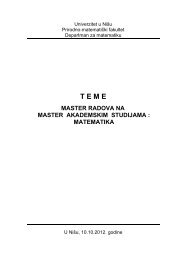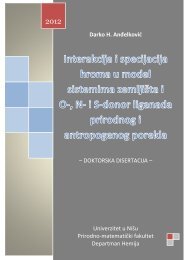Bicyclic graphs with minimal values of the detour index
Bicyclic graphs with minimal values of the detour index
Bicyclic graphs with minimal values of the detour index
Create successful ePaper yourself
Turn your PDF publications into a flip-book with our unique Google optimized e-Paper software.
Filomat 26:6 (2012), 1263–1272<br />
DOI 10.2298/FIL1206263K<br />
Published by Faculty <strong>of</strong> Sciences and Ma<strong>the</strong>matics,<br />
University <strong>of</strong> Niˇs, Serbia<br />
Available at: http://www.pmf.ni.ac.rs/filomat<br />
<strong>Bicyclic</strong> <strong>graphs</strong> <strong>with</strong> <strong>minimal</strong> <strong>values</strong> <strong>of</strong> <strong>the</strong> <strong>detour</strong> <strong>index</strong><br />
ˇZana Kovijanić Vukićević a , Vladimir Boˇzović b<br />
a Faculty <strong>of</strong> Natural Sciences and Ma<strong>the</strong>matics, University <strong>of</strong> Montenegro, 81000 Podgorica, Montenegro<br />
b Faculty <strong>of</strong> Natural Sciences and Ma<strong>the</strong>matics, University <strong>of</strong> Montenegro, 81000 Podgorica, Montenegro<br />
Abstract. We are looking for <strong>the</strong> <strong>graphs</strong> <strong>with</strong> <strong>minimal</strong> <strong>detour</strong> <strong>index</strong> in <strong>the</strong> class <strong>of</strong> connected bicyclic<br />
<strong>graphs</strong>. For <strong>the</strong> fixed number <strong>of</strong> vertices, we split <strong>the</strong> problem into two cases: bicyclic <strong>graphs</strong> <strong>with</strong>out<br />
common edges between cycles and <strong>the</strong> complement <strong>of</strong> it. In both cases, we find <strong>graphs</strong> <strong>with</strong> <strong>minimal</strong><br />
<strong>detour</strong> <strong>index</strong>.<br />
1. Introduction<br />
Topological indices are <strong>the</strong> numbers that reflect certain structural characteristics <strong>of</strong> organic molecules,<br />
obtained from <strong>the</strong> respective <strong>graphs</strong>. One <strong>of</strong> <strong>the</strong> oldest and <strong>the</strong> most completely analyzed is <strong>the</strong> Wiener<br />
<strong>index</strong> or <strong>the</strong> Wiener number.<br />
Let G = (V, E) be a simple connected graph. The distance between vertices u, v ∈ V in G is <strong>the</strong> length <strong>of</strong><br />
<strong>the</strong> shortest path between <strong>the</strong>m denoted by d(u, v) or dG(u, v). The Wiener <strong>index</strong> <strong>of</strong> <strong>the</strong> graph G is defined<br />
as<br />
∑<br />
W(G) = dG(u, v).<br />
That is<br />
W(G) = 1<br />
2<br />
{u,v}⊆V(G)<br />
∑<br />
DG(u)<br />
u∈V<br />
∑<br />
where DG(u) is <strong>the</strong> sum DG(u) = dG(u, v), for any vertex u ∈ V.<br />
v∈V<br />
The Wiener <strong>index</strong> was first proposed by Harold Wiener [3] as an aid to determining <strong>the</strong> boiling point <strong>of</strong><br />
paraffin. In particular, he mentions in his article that <strong>the</strong> boiling point tB can be quite closely approximated<br />
by <strong>the</strong> formula<br />
tB = aw + bp + c,<br />
where w is <strong>the</strong> Wiener <strong>index</strong>, p <strong>the</strong> polarity number and a, b and c are constants for a given isomeric group.<br />
Since <strong>the</strong>n, it was observed that <strong>the</strong> Wiener <strong>index</strong> has a connection to a host <strong>of</strong> o<strong>the</strong>r properties <strong>of</strong> molecules<br />
2010 Ma<strong>the</strong>matics Subject Classification. 05C12, 05C35, 05C90.<br />
Keywords. bicyclic <strong>graphs</strong>; topological <strong>index</strong>; <strong>detour</strong> <strong>index</strong>; Wiener <strong>index</strong>; <strong>minimal</strong> <strong>detour</strong> <strong>index</strong>; longest distance<br />
Received: 04 April 2012; Accepted: 29 May 2012<br />
Communicated by Dragan Stevanović<br />
Email addresses: zanak@t-com.me ( ˇZana Kovijanić Vukićević), vladobozovic@yahoo.com (Vladimir Boˇzović)
ˇZ. K.Vukićević, V.Boˇzović / Filomat 26:6 (2012), 1263–1272 1264<br />
(viewed as <strong>graphs</strong>). For more information about <strong>the</strong> Wiener <strong>index</strong> in chemistry and ma<strong>the</strong>matics see [5]<br />
and [4], respectively.<br />
Ano<strong>the</strong>r topological <strong>index</strong>, called <strong>the</strong> <strong>detour</strong> <strong>index</strong>, is conceptually close to Wiener <strong>index</strong>, except that its<br />
definition refers to <strong>the</strong> longest distance instead <strong>of</strong> <strong>the</strong> shortest distance between two graph vertices. The <strong>detour</strong><br />
<strong>index</strong> ω(G), where G denotes <strong>the</strong> underlying graph, has been introduced by Amić and Trinajstić [8] and by<br />
John [9] independently<br />
∑<br />
ω(G) = lG(u, v),<br />
{u,v}⊆V(G)<br />
where lG(u, v) is <strong>the</strong> length <strong>of</strong> <strong>the</strong> longest path between two vertices.<br />
The length lG(u, v) <strong>of</strong> <strong>the</strong> longest path is also called <strong>detour</strong> distance between vertices u, v ∈ V in G. When<br />
it is clear from a context which underlying graph G is assumed, we simply write l(u, v) instead <strong>of</strong> lG(u, v).<br />
Also, we define<br />
ω(G) = 1<br />
2<br />
∑<br />
LG(u)<br />
u∈V<br />
∑<br />
where LG(u) is <strong>the</strong> sum LG(u) = lG(u, v), for any vertex u ∈ V.<br />
v∈V<br />
Recently, as for Wiener <strong>index</strong>, it’s been presented significance <strong>of</strong> <strong>detour</strong> <strong>index</strong> in <strong>the</strong> structure-boiling point<br />
relation [6], [7].<br />
The main goal <strong>of</strong> this paper is to find <strong>graphs</strong> <strong>with</strong> <strong>minimal</strong> <strong>detour</strong> <strong>index</strong> among <strong>the</strong> class <strong>of</strong> connected<br />
bicyclic <strong>graphs</strong> <strong>with</strong> n vertices. For <strong>the</strong> rest <strong>of</strong> paper, we treat exclusively connected type <strong>of</strong> <strong>graphs</strong>.<br />
In <strong>the</strong> Section 2 we give review <strong>of</strong> important terminology and <strong>the</strong>ory regarding main problem, mostly<br />
based on papers [1] and [2].<br />
The case <strong>of</strong> bicyclic <strong>graphs</strong> <strong>with</strong>out common edges between two cycles is treated in Section 3. We found,<br />
by Theorem 3, that <strong>the</strong> smallest <strong>detour</strong> <strong>index</strong> in <strong>the</strong> corresponding class is n 2 + 2n − 7. It is attained at so<br />
called n−vertex butterfly, that looks like two triangles having one vertex in common and all o<strong>the</strong>r n − 5<br />
vertices are attached as pendent vertices to that common vertex (Figure 1).<br />
The most interesting and consequently <strong>the</strong> most complex case, subject <strong>of</strong> Section 4, is about bicyclic<br />
<strong>graphs</strong> <strong>with</strong> common edges between two cycles. The central role in this section has a Theorem 4 which<br />
brings out an iterative procedure <strong>of</strong> converting given graph to <strong>the</strong> one <strong>with</strong> smaller <strong>detour</strong> <strong>index</strong>. According<br />
to our result, <strong>the</strong> smallest <strong>detour</strong> <strong>index</strong> for this class has <strong>the</strong> graph that looks like two glued triangles by<br />
one side, making a parallelogram, and all o<strong>the</strong>r n − 4 pendent vertices are attached to one <strong>of</strong> two common<br />
vertices <strong>of</strong> those triangles (Figure 3).<br />
2. Preliminaries<br />
Let H = (V(H), E(H)) be graph <strong>with</strong>out pendent vertices and V(H) = {v1, v2, . . . , vn}. Let T1, T2, . . . , Tn be<br />
vertex disjoint trees such that H and Ti have exactly one vertex vi in common, for 1 ≤ i ≤ n. Such graph<br />
is denoted by H(T1, T2, . . . , Tn). Let Sn and Pn be <strong>the</strong> n-vertex star and path, respectively. Let Cn be a cycle<br />
graph <strong>with</strong> n vertices.<br />
The next assertion is valid for arbitrary cyclic graph. Although <strong>the</strong> pro<strong>of</strong> <strong>of</strong> <strong>the</strong> next lemma is almost<br />
<strong>the</strong> same as for similar assertion proved in paper by Zhou and Cai [1], as well as in [11], we include it to<br />
facilitate reading <strong>the</strong> rest <strong>of</strong> <strong>the</strong> paper.
ˇZ. K.Vukićević, V.Boˇzović / Filomat 26:6 (2012), 1263–1272 1265<br />
Lemma 1. Let H = (V(H), E(H)) be graph <strong>with</strong>out pendent vertices and G = H(T1, T2, . . . , Tn). Then<br />
ω(G) =<br />
n∑<br />
W(Ti) +<br />
i=1<br />
∑<br />
1≤i
ω(G) = ω(G1) + ω(G2) + LG1<br />
ˇZ. K.Vukićević, V.Boˇzović / Filomat 26:6 (2012), 1263–1272 1266<br />
(a1)|V2 − 1| + LG2 (a2)|V1 −<br />
3. <strong>Bicyclic</strong> <strong>graphs</strong> <strong>with</strong> cycles <strong>with</strong>out common edges<br />
v3<br />
Let Bn;k,m be a class <strong>of</strong> bicyclic <strong>graphs</strong> <strong>with</strong> n−vertices, whose cycles have∪k and m vertices and don’t<br />
have common edges. We are going to prove that <strong>the</strong> smallest <strong>detour</strong> <strong>index</strong> in Bn;k,m, for n ≥ 5, has <strong>the</strong><br />
so called n-vertex butterfly B ∈ Bn;3,3, <strong>the</strong> graph presented in <strong>the</strong> next figure<br />
v2<br />
v1<br />
v4<br />
E(G 1 ∗G 2 ) = {(u, a )|(u, a1) ∈ E1}∪{(u, a )|(u, a2) ∈ E2}∪{(u, v<br />
We use this notation in <strong>the</strong> pro<strong>of</strong> <strong>of</strong> <strong>the</strong> following <strong>the</strong>or<br />
version was recently proved in [10].<br />
Theorem 2. Let G1 = (V1, E1), G2 = (V2, E2) and G = G a1<br />
1<br />
3≤k≤m<br />
∗ G
Pro<strong>of</strong>.<br />
ˇZ. K.Vukićević, V.Boˇzović / Filomat 26:6 (2012), 1263–1272 1267<br />
∑ ∑<br />
ω(G) = l(u, v) + l(u, v) +<br />
{u,v}⊆V1<br />
{u,v}⊆V2 ∑ ∑<br />
= ω(G1) + ω(G2) +<br />
u∈V1\{a1} v∈V2\{a2}<br />
∑<br />
l(u, v)<br />
u∈V1\{a1}, v∈V2\{a2}<br />
(l(u, a ∗ ) + l(a ∗ , v))<br />
= ω(G1) + ω(G2) + LG1 (a1)|V2 − 1| + LG2 (a2)|V1 − 1|.<br />
Theorem 3. Let G be a n-vertex bicyclic graph whose cycles have no common edges and n ≥ 5. Then<br />
ω(G) ≥ ω(B) = n 2 + 2n − 7,<br />
where B is <strong>the</strong> n−vertex butterfly (Figure 1).<br />
Pro<strong>of</strong>. Let G be an arbitrary bicyclic graph <strong>with</strong> n vertices whose cycles have no common edges. Then<br />
G = G a1 ∗ Ga2<br />
1 2 for some unicyclic <strong>graphs</strong> G1 ∈ Un1,p and G2 ∈ Un2,q such that n = n1 + n2 − 1. Due to previous<br />
<strong>the</strong>orem<br />
ω(G) = ω(G1) + ω(G2) + LG1 (a1)(n2 − 1) + LG2 (a2)(n1 − 1).<br />
By Proposition 1 we have<br />
ω(G1) ≥ ω(Sn1,3) and ω(G2) ≥ ω(Sn2,3) <strong>with</strong> equalities if and only if G1 = Sn1,3 and G2 = Sn2,3.<br />
From Theorem 1 it follows<br />
LG1 (a1) ≥ n1 + 1 and LG2 (a2) ≥ n2 + 1,<br />
<strong>with</strong> equalities if and only if a1 and a2 are vertices in Sn1,3 and Sn2,3 <strong>with</strong> n1 − 2 and n2 − 2 pendent vertices,<br />
respectivelly. Hence<br />
ω(G) ≥ ω(Sn1,3) + ω(Sn2,3) + (n1 + 1)(n2 − 1) + (n2 + 1)(n1 − 1)<br />
= n 2<br />
1<br />
− 3 + n2<br />
2 − 3 + 2n1n2 − 2 = n 2 + 2n − 7.<br />
We conclude that ω(G) = n 2 + 2n − 7 if and only if Gi = Sni,3 and ai has ni − 2 pendent vertices, for i = 1, 2.<br />
In this case, G is actually B, <strong>the</strong> n-vertex butterfly.<br />
4. <strong>Bicyclic</strong> <strong>graphs</strong> <strong>with</strong> cycles <strong>with</strong> common edges<br />
Denote by En(s, p1, p2), s ≥ p1 ≥ p2 ≥ 1, p1 ≥ 2, <strong>the</strong> class <strong>of</strong> n−vertex bicyclic <strong>graphs</strong>, n ≥ 4, whose cycles<br />
R1, R2 have at least one common edge, where<br />
s = |E(R1) ∩ E(R2)|, p1 = |E(R1) \ E(R2)| and p2 = |E(R2) \ E(R1)|.<br />
Described class is illustrated in <strong>the</strong> following figure
aph depictured in <strong>the</strong> following<br />
x1<br />
x2<br />
ˇZ. K.Vukićević, V.Boˇzović / Filomat 26:6 (2012), 1263–1272 1268<br />
xp 1 −1<br />
R2<br />
R1
R1<br />
ˇZ. K.Vukićević, V.Boˇzović / Filomat 26:6 (2012), 1263–1272 1269<br />
R2<br />
R1<br />
R2<br />
G
ˇZ. K.Vukićević, V.Boˇzović / Filomat 26:6 (2012), 1263–1272 1270<br />
For u ∈ B, let � ′ be an (u, b)−path in G ′ <strong>with</strong> length lG ′(u, b). There are two possibilities: e′ = (vs−2, b) � � ′<br />
or e ′ = (vs−2, b) ∈ � ′ . Suppose that e ′ = (vs−2, b) � � ′ . Then, � = � ′ + (b, vs−1) is (u, vs−1)−path in G and so<br />
lG(u, vs−1) ≥ |�| = |� ′ | + 1 = lG ′(u, b) + 1 = lG ′(u, vs−1).<br />
If e ′ = (vs−2, b) ∈ � ′ , replace <strong>the</strong> edge e ′ by (vs−2, vs−1). We obtain an (u, vs−1)−path in <strong>the</strong> graph G. Path<br />
� = � ′ −(b, vs−2)+(vs−2, vs−1) doesn’t pass across <strong>the</strong> vertex b and, since u ∈ B, it is not <strong>the</strong> longest (u, vs−1)−path.<br />
Hence,<br />
That is<br />
lG(u, vs−1) > |�| = |� ′ | = lG ′(u, b) = lG ′(u, vs−1) − 1.<br />
lG(u, vs−1) ≥ lG ′(u, vs−1).<br />
It follows that<br />
lG(u, vs−1) − lG ′(u, vs−1) ≥ 0, for u ∈ B.<br />
From this inequality we conclude that<br />
∑<br />
[lG(u, vs−1) − lG ′(u, vs−1)]<br />
∑<br />
≥ [lG(u, vs−1) − lG ′(u, vs−1)] (3)<br />
u∈T<br />
u∈A<br />
Let u ∈ A and let � be an (u, vs−1)−path <strong>with</strong> length lG(u, vs−1) such that � doesn’t pass across b. Then<br />
h = � + (vs−1, b) is an (u, b)−path. We are going to prove that its length is lG(u, b). If opposite, <strong>the</strong>re is an<br />
(u, b)−path ˜ h in <strong>the</strong> graph G, such that | ˜ h| > |h| = lG(u, vs−1) + 1. Therefore (vs−1, b) � ˜ h. So, ˜ h + (b, vs−1) is<br />
(u, vs−1)−path <strong>with</strong> length | ˜ h| + 1 > lG(u, vs−1), that is not possible. Hence,<br />
lG(u, b) = lG(u, vs−1) + 1<br />
We are going to show that for u ∈ A <strong>the</strong> longest (u, b)−path in G ′ passes across <strong>the</strong> vs−2.<br />
Suppose opposite. Let � ′ be an (u, b)−path <strong>with</strong> length lG ′(u, b) such that vs−2 � � ′ . Then, � = � ′ +(b, vs−1) is<br />
(u, vs−1)−path in G. Since u ∈ A in G <strong>the</strong>re is <strong>the</strong> longest (u, vs−1)−path h such that b � h. Replacing <strong>the</strong> vertex<br />
vs−1 on <strong>the</strong> path h <strong>with</strong> <strong>the</strong> vertex b in G ′ we obtain an (u, b)−path h ′ . Then |h ′ | = |h| ≥ |�| > |� ′ | = lG ′(u, b),<br />
that is not possible. So, <strong>the</strong> longest (u, b)−path in G ′ passes across <strong>the</strong> vs−2. Denote by ˜� one such path. Let<br />
� = ˜� − (b, vs−2) + (vs−2, vs−1). It follows that<br />
Hence,<br />
Therefore,<br />
lG(u, vs−1) ≥ |�| = | ˜�| = lG ′(u, b).<br />
lG ′(u, vs−1) = 1 + lG ′(u, b) ≤ 1 + lG(u, vs−1) and lG(u, b) = lG(u, vs−1) + 1 ≥ lG ′(u, b) + 1.<br />
lG(u, vs−1) − lG ′(u, vs−1) ≥ −1 for u ∈ A, (4)<br />
lG(u, b) − lG ′(u, b) ≥ 1 for u ∈ A. (5)<br />
Since lG(u, b) − lG ′(u, b) ≥ 0 for u ∈ B we have that<br />
∑<br />
∑<br />
[lG(u, b) − lG ′(u, b)] ≥ [lG(u, b) − lG ′(u, b)]<br />
u∈T<br />
u∈A<br />
and so from (1) - (3) we have<br />
ω(G) − ω(G ′ ∑<br />
) ≥ 2 + [lG(u, vs−1) − lG ′(u, vs−1)]<br />
∑<br />
+ [lG(u, b) − lG ′(u, b)]<br />
u∈A<br />
u∈A<br />
Using (4) and (5) we finally conclude ω(G) − ω(G ′ ) ≥ 2.
ˇZ. K.Vukićević, V.Boˇzović / Filomat 26:6 (2012), 1263–1272 1271<br />
Previous <strong>the</strong>orem introduces, in a subtle way, <strong>the</strong> procedure <strong>of</strong> iterative reducing cycles R1 and R2 by<br />
absorbing two vertices into one. Namely, every bicyclic graph <strong>with</strong> common edges between two cycles,<br />
could be isomorphically transformed into graph that belongs to class En(s, p1, p2), i.e. that middle path is<br />
<strong>the</strong> longest one. For example, two <strong>graphs</strong> in <strong>the</strong> following picture <strong>the</strong>re are two isomorphic <strong>graphs</strong> that<br />
belong to E4(2, 2, 1).<br />
C<br />
D
ˇZ. K.Vukićević, V.Boˇzović / Filomat 26:6 (2012), 1263–1272 1272<br />
Theorem 5. Let G = D(T1, T2, T3, T4) such that |T2| ≤ |T4|. For any fixed i ∈ {1, 2, 3} let G ′ be a graph obtained<br />
from G removing all pendent vertices from <strong>the</strong> vertex vi to <strong>the</strong> vertex v4. Then ω(G) > ω(G ′ ).<br />
Pro<strong>of</strong>.<br />
ω(G) − ω(G ′ ) =<br />
=<br />
−<br />
=<br />
∑ ∑ ∑<br />
[lG(t, u) − lG ′(t, u)]<br />
t∈Ti j�i u∈Tj<br />
t�vi<br />
∑ ∑ ∑<br />
[(1 + lD(vi, vj) + l(vj, u))<br />
t∈Ti j�i u∈Tj<br />
t�vi<br />
∑ ∑ ∑<br />
(1 + lD(v4, vj) + l(vj, u))]<br />
t∈Ti j�i u∈Tj<br />
t�vi<br />
∑ ∑ ∑<br />
[lD(vi, vj) − lD(v4, vj)]<br />
t∈Ti<br />
t�vi<br />
j�i u∈Tj<br />
Due to (6), lD(vi, vj) − lD(v4, vj) > 0, so ω(G) > ω(G ′ ).<br />
5. Conlusions<br />
In this paper we studied <strong>detour</strong> <strong>index</strong> <strong>of</strong> connected bicyclic <strong>graphs</strong>. The main goal was to find <strong>the</strong><br />
<strong>graphs</strong> <strong>with</strong> <strong>minimal</strong> <strong>detour</strong> <strong>index</strong> in <strong>the</strong> defined class. The problem was separated into two cases: bicyclic<br />
<strong>graphs</strong> <strong>with</strong>out and <strong>with</strong> common edges between two cycles.<br />
In <strong>the</strong> first case, we realized that every connected bicyclic graph G, <strong>with</strong>out common edges, is made by<br />
merging two vertices <strong>of</strong> unicyclic <strong>graphs</strong> G1 and G2 into single vertex, as described in Section 3. That observation<br />
helped us to find <strong>the</strong> graph, so called n−vertex butterfly Bn;3,3, <strong>with</strong> <strong>minimal</strong> <strong>detour</strong> <strong>index</strong> n 2 +2n−7.<br />
The second case, problem <strong>of</strong> bicyclic <strong>graphs</strong> <strong>with</strong> common edges, is mainly resolved in <strong>the</strong> Theorem 4.<br />
In that <strong>the</strong>orem we introduced iterative procedure <strong>of</strong> removing a common edge between two cycles and<br />
attaching to <strong>the</strong> specific node which resulted in getting a new graph <strong>with</strong> smaller <strong>detour</strong> <strong>index</strong>. Once we<br />
reduced <strong>the</strong> problem to <strong>the</strong> case <strong>of</strong> parallelogram <strong>with</strong> attached stars to <strong>the</strong> four parallelogram vertices, as<br />
showed in <strong>the</strong> Figure 6, <strong>the</strong>n Theorem 5 resolves that <strong>the</strong> smallest <strong>detour</strong> <strong>index</strong> has <strong>the</strong> graph represented<br />
in <strong>the</strong> Figure 3.<br />
For <strong>the</strong> future research, it might be worth trying <strong>of</strong> finding <strong>the</strong> exact <strong>values</strong> <strong>of</strong> <strong>detour</strong> <strong>index</strong> for some<br />
particular type <strong>of</strong> <strong>graphs</strong>. It looks that <strong>the</strong> case <strong>of</strong> bicyclic <strong>graphs</strong> <strong>with</strong>out common edges or <strong>the</strong> case <strong>of</strong><br />
bicyclic <strong>graphs</strong> <strong>with</strong> just one edge in common could be, <strong>with</strong> some lengthy algebraic calculations, finally<br />
resolved. If that is achieved, <strong>the</strong>n some <strong>of</strong> <strong>the</strong> results <strong>of</strong> this paper would be easily obtained.<br />
References<br />
[1] B. Zhou, X. Cai, On <strong>detour</strong> <strong>index</strong>, MATCH Commun. Math. Comput. Chem 63 (2010), 199–210.<br />
[2] A. A. Dobrynin, R. Entringer, I. Gutman, Wiener <strong>index</strong> <strong>of</strong> trees: Theory and application, Acta Appl. Math. 6 (2001), 211–249.<br />
[3] H. Wiener, Structural determination <strong>of</strong> paraffin boiling points, J. Amer.Chem. Soc. 69 (1947), 17–20.<br />
[4] I. Gutman and O. Polansky, Ma<strong>the</strong>matical Concepts in Organic Chemistry, Springer-Verlag, Berlin, Germany, 1986.<br />
[5] F. Buckley and F. Harary, Distance in Graphs, Addison-Wesley, Redwood, CA, 1990.<br />
[6] N. Trinajstić, S. Nikolić, B. Lučić, D. Amić, Z. Mihalić, The Detour Matrix in Chemistry, J. Chem. Inf. Comput. Sci. 1997, 37,<br />
631–638.<br />
[7] I. Lukovits, The Detour Index, Croat. Chem. Acta 1996, 69, 873–882.<br />
[8] D. Amić, N. Trinajstić, On <strong>the</strong> Detour Matrix, Croat. Chem. Acta 1995, 68, 53–62.<br />
[9] P. John, On <strong>the</strong> computation <strong>of</strong> <strong>the</strong> Wiener <strong>index</strong> <strong>of</strong> selected Delta-dimensional lattice structures, MATCH Commun. Math. Chem.<br />
1995, 32, 207–219.<br />
[10] X. Qi, B. Zhou, Maximum <strong>detour</strong> <strong>index</strong> <strong>of</strong> unicyclic <strong>graphs</strong> <strong>with</strong> given maximum degree, Ars Combin. 2011, 102, 193–200.<br />
[11] X. Qi, B. Zhou, Detour <strong>index</strong> <strong>of</strong> a class <strong>of</strong> unicyclic <strong>graphs</strong>, Filomat 2010, 24 (no. 1), 29–40.
















